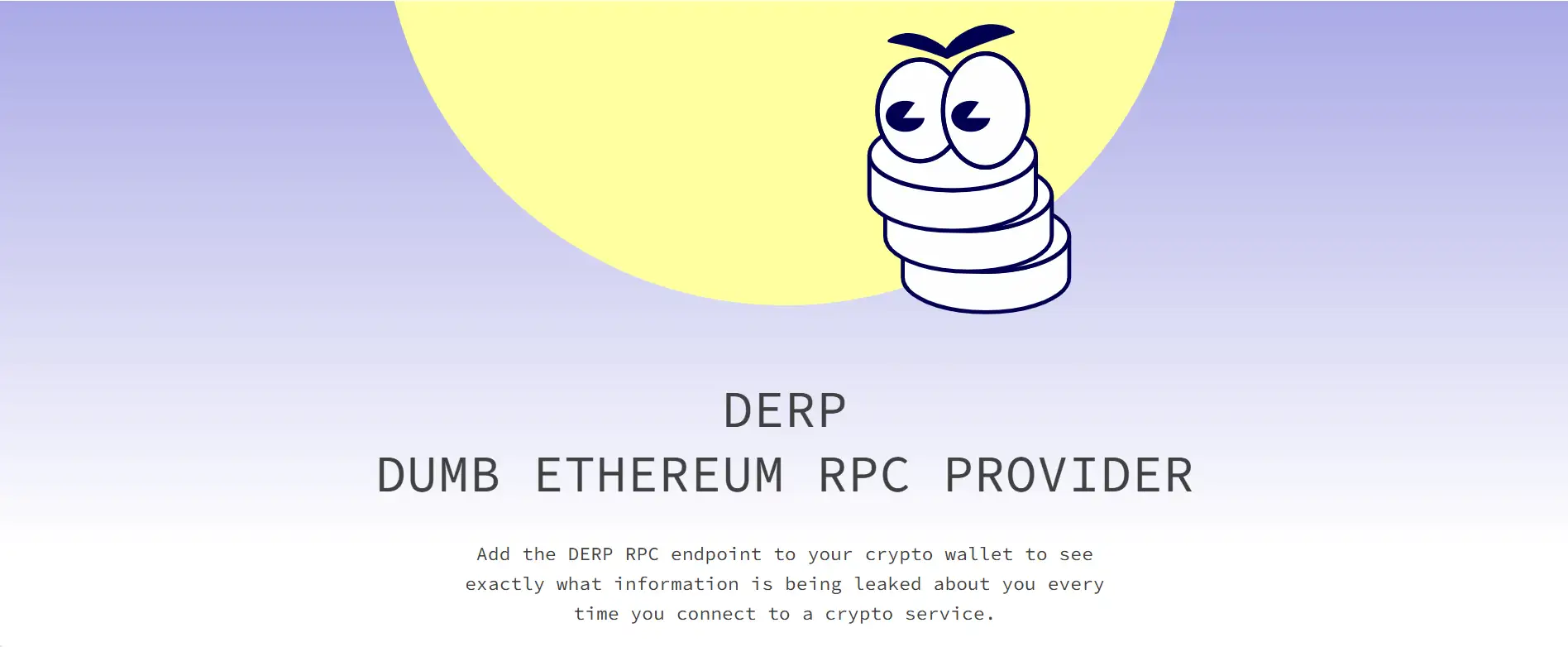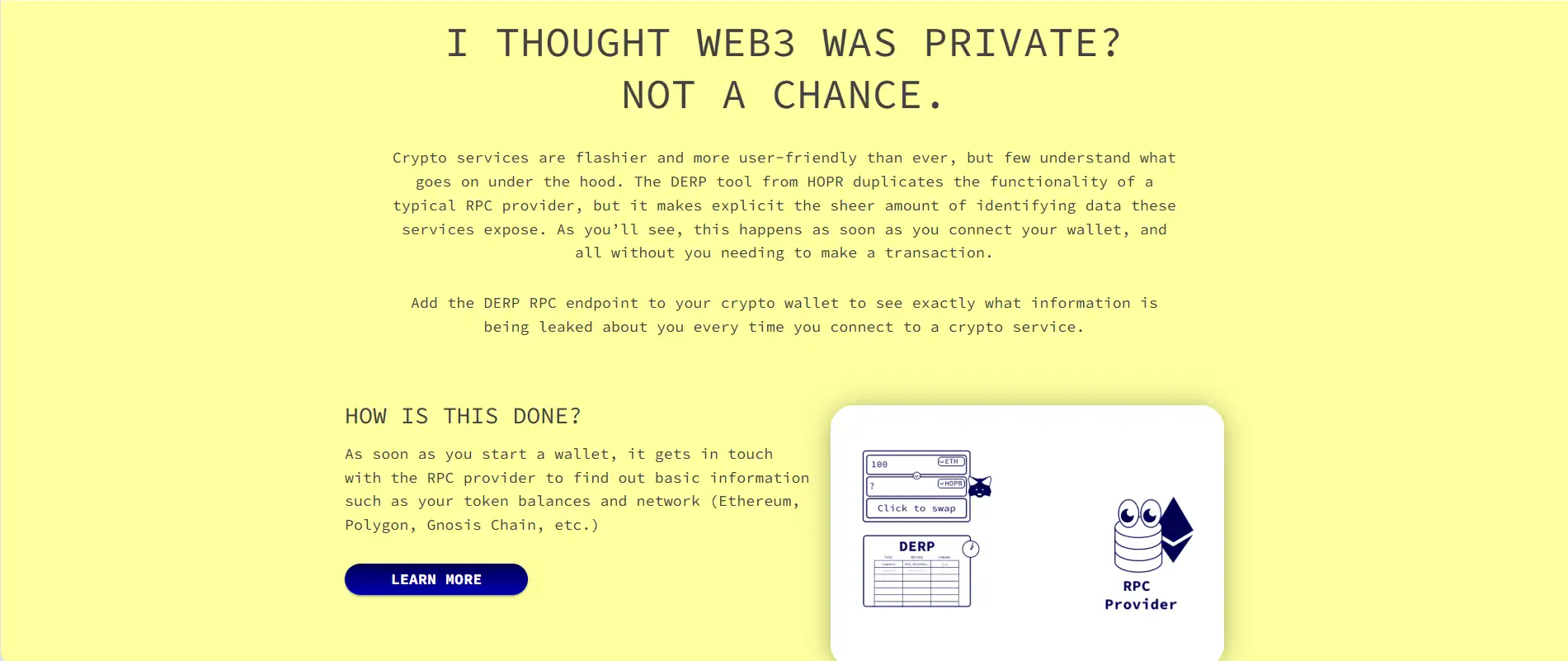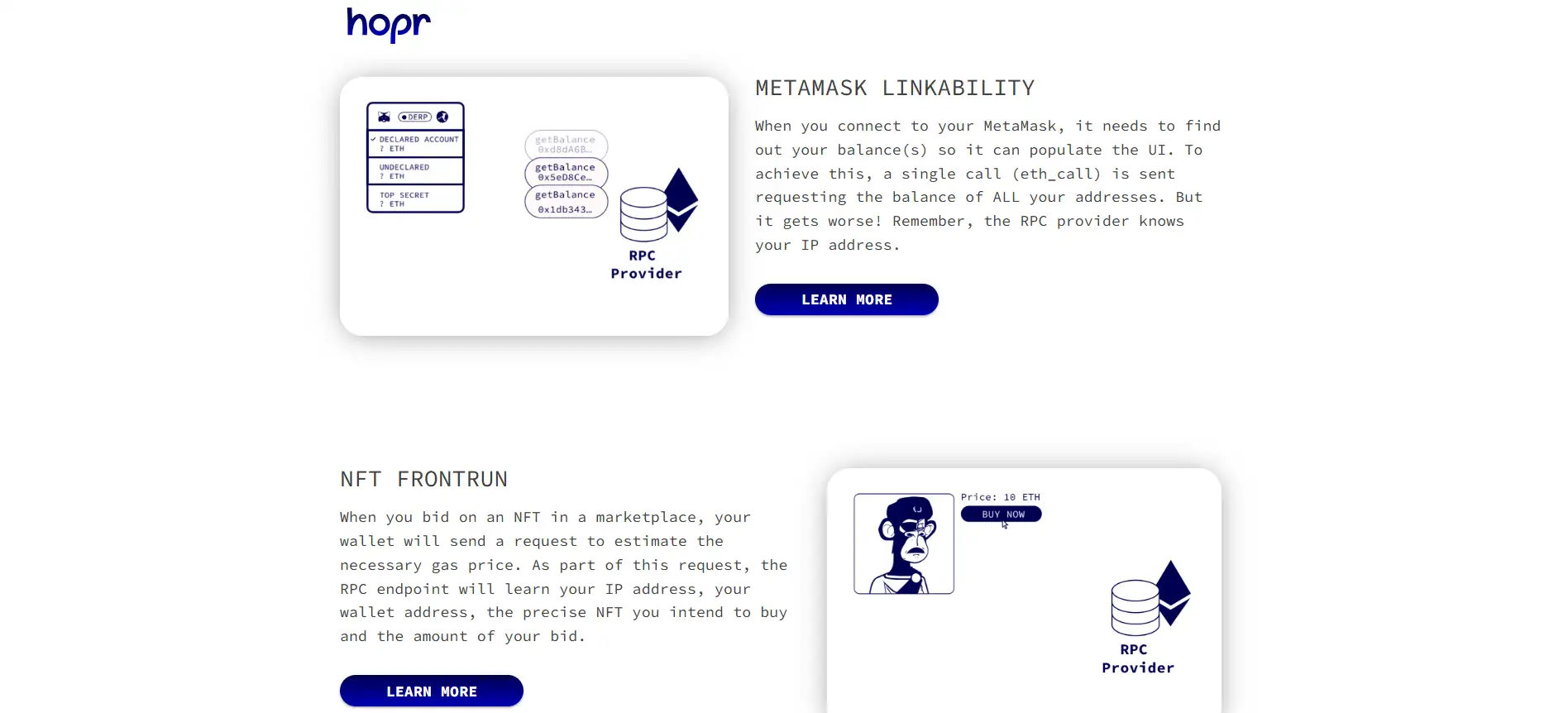About Hopr Network
HOPR is a decentralized, privacy-first protocol that addresses one of the biggest flaws in Web3 infrastructure: the lack of transport layer privacy. While many users believe Web3 guarantees anonymity, the truth is that your wallet leaks significant metadata — such as IP address, location, and browser — whenever it connects to a service. HOPR exposes and solves this issue through a suite of tools, including the DERP (Dumb Ethereum RPC Provider) interface, which lets users visualize the metadata they unknowingly share.
The mission of HOPR is to create the infrastructure for a truly private Web3 experience. By running a decentralized mixnet, incentivizing node operators, and providing accessible developer APIs, HOPR gives individuals, organizations, and dApps the power to protect their users’ data across networks like Ethereum, Gnosis, and Polygon. HOPR isn’t just theoretical privacy — it’s privacy you can build on.
HOPR is a decentralized privacy infrastructure protocol that provides full control over metadata privacy in digital communication. At a time when Web3 is marketed as private and anonymous, HOPR exposes how routine wallet interactions leak sensitive data—such as IP addresses, location, and browsing metadata—to RPC providers. Through its demo tool DERP (Dumb Ethereum RPC Provider), users can visualize this leak in real time by simply connecting a wallet. The project’s goal is to bring transparency to these interactions and offer a robust alternative that secures the transport layer of Web3.
The backbone of the HOPR protocol is a decentralized, incentivized mixnet, which routes encrypted packets through multiple nodes, making the source, content, and destination completely indistinguishable. This design solves the problem of metadata exposure that plagues existing dApps and wallet services—even when users are behind VPNs. The mixnet is powered by a proof-of-relay mechanism that rewards node operators in $HOPR tokens for successfully relaying data. To prevent analysis of real traffic flows, the network also generates cover traffic, creating statistical noise that enhances anonymity.
Developers can interact with the HOPR network through high-level APIs to build fully private decentralized applications, whether they’re in healthcare, DeFi, energy, or data-sensitive enterprise environments. Because the HOPR network is layer-2 optimized using probabilistic micropayments, it avoids costly on-chain transaction fees while maintaining decentralized settlement. Anyone can set up a HOPR node using their own hardware or via Docker and cloud services, making participation in the privacy network accessible and scalable.
While HOPR focuses explicitly on transport-level privacy, other projects attempt to address privacy at different layers. Aztec Network uses zero-knowledge proofs to provide transaction-level anonymity via private smart contracts. Nym offers a similar mixnet architecture but is not blockchain-native. Orion Protocol specializes in decentralized liquidity aggregation but lacks any metadata-level privacy solutions. Compared to these, HOPR uniquely addresses the overlooked but critical layer of metadata protection, positioning itself as a foundational privacy protocol for the evolving Web3 ecosystem.
HOPR offers a robust suite of features and benefits that directly tackle the blind spots in current Web3 infrastructure:
- DERP Privacy Demonstrator: The DERP interface shows users what metadata (e.g., IP, network, city, wallet address) is leaked every time they open their wallet.
- Decentralized Mixnet: HOPR’s network relays encrypted data packets across multiple nodes, preventing tracking or analysis of communication patterns.
- Proof-of-Relay Incentives: Node runners earn $HOPR tokens for successfully relaying data, providing a financial incentive to maintain the privacy layer.
- Cover Traffic Protection: The network generates decoy traffic to make it statistically impossible to detect real transactions or packet flows.
- Cross-Sector Use Cases: Ideal for use in healthcare, decentralized finance, energy markets, and any service requiring strict metadata anonymity.
- Developer Friendly: APIs and tooling allow seamless integration with dApps, services, and private infrastructure layers.
- Scalable Architecture: Built using layer-2 scaling, HOPR supports probabilistic micropayments without excessive gas fees.
- Community Driven: Open source, globally distributed, and backed by a dedicated privacy-focused community and ecosystem.
Getting started with HOPR is simple for both end users and developers:
- Use DERP: Visit the DERP demo and add the RPC endpoint to your wallet (e.g. MetaMask) to view your real-time metadata leaks.
- Run a Node: Download the node software from GitHub and start relaying encrypted traffic. Nodes can run on Windows, macOS, Linux, Docker, and cloud servers.
- Stake & Earn: Visit the HOPR Staking Hub to lock tokens and earn passive income through proof-of-relay incentives.
- Integrate with dApps: Use HOPR’s APIs to build privacy-preserving applications or integrate metadata protection into existing infrastructure.
- Read the Docs: Learn about tokenomics, node architecture, and integration guides at the official HOPR documentation site.
- Join the Community: Get support and engage with developers via Discord, Twitter, and Medium.
Hopr Network FAQ
DERP, created by HOPR, is an educational RPC endpoint that mimics what traditional Ethereum RPC providers do behind the scenes. By simply connecting a wallet, users can see in real time what kind of metadata is exposed, including their IP address, wallet address, browser type, and even intended actions like NFT bids or DEX swaps. DERP doesn’t solve the problem—it reveals it, helping users understand why tools like RPCh and the HOPR mixnet are necessary.
Transport layer privacy protects the metadata around a transaction—like who sent it, when, from where, and to whom—whereas transaction privacy usually refers to hiding amounts or balances on-chain. HOPR focuses on the former, using a mixnet to obfuscate communication paths and prevent adversaries from linking messages to users. This kind of privacy-by-default is essential for making Web3 secure against surveillance and censorship.
While VPNs only encrypt the channel between you and the VPN server, HOPR’s decentralized mixnet breaks metadata linkability altogether. Data is split into packets and sent through multiple randomized hops, making it impossible to trace the origin or destination—even for a global adversary. This design, combined with cover traffic, ensures that real activity is indistinguishable from decoys, providing full metadata privacy.
Proof-of-relay is HOPR’s mechanism to ensure nodes only get paid when they successfully relay encrypted data. Each packet includes a cryptographic challenge that must be completed by the receiving node to earn $HOPR tokens. This ensures honest behavior across the network without the need for central oversight, and forms the foundation of HOPR’s token-incentivized privacy infrastructure.
Yes, the HOPR protocol offers high-level developer APIs that abstract away the complexities of the mixnet. Developers can add transport-level privacy to their apps without altering the front-end UX. With support for Docker, native installs, and cloud environments, integration is flexible and scalable. Learn more in the official HOPR documentation.
You Might Also Like












